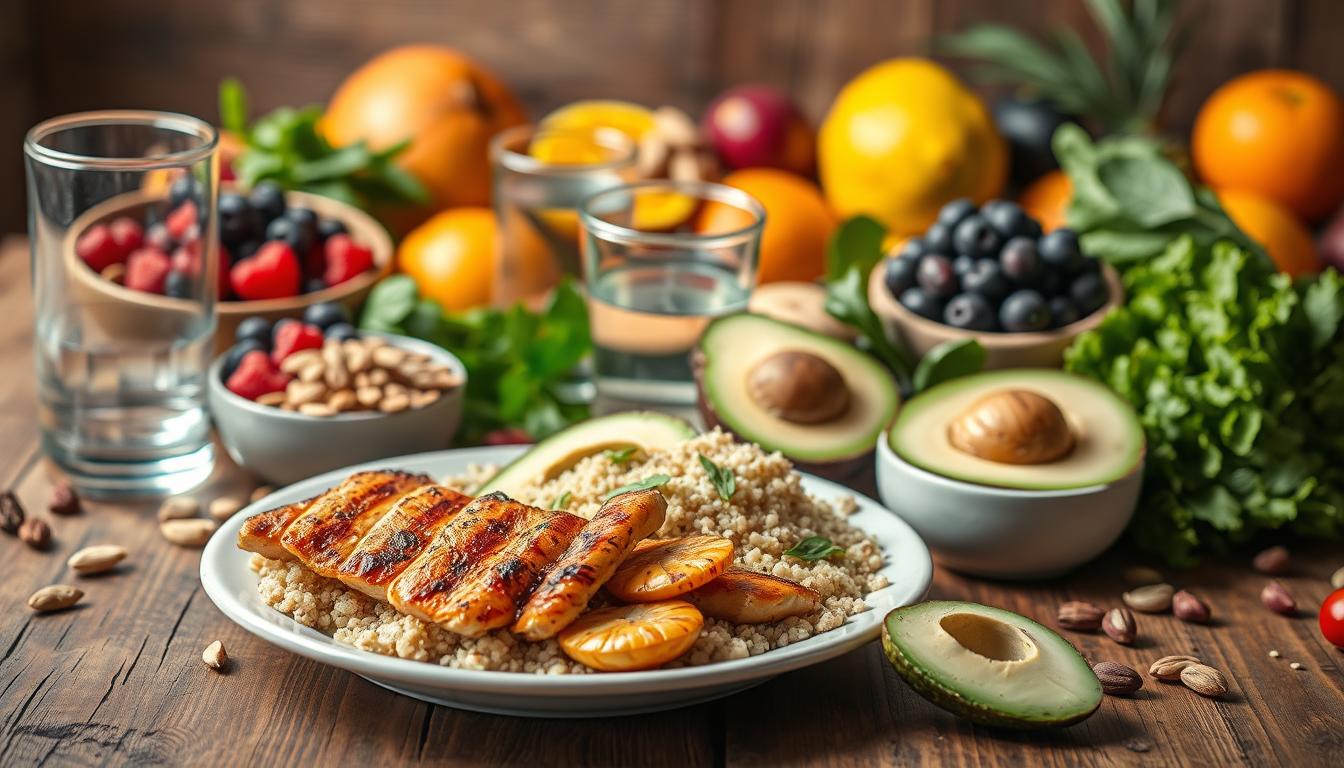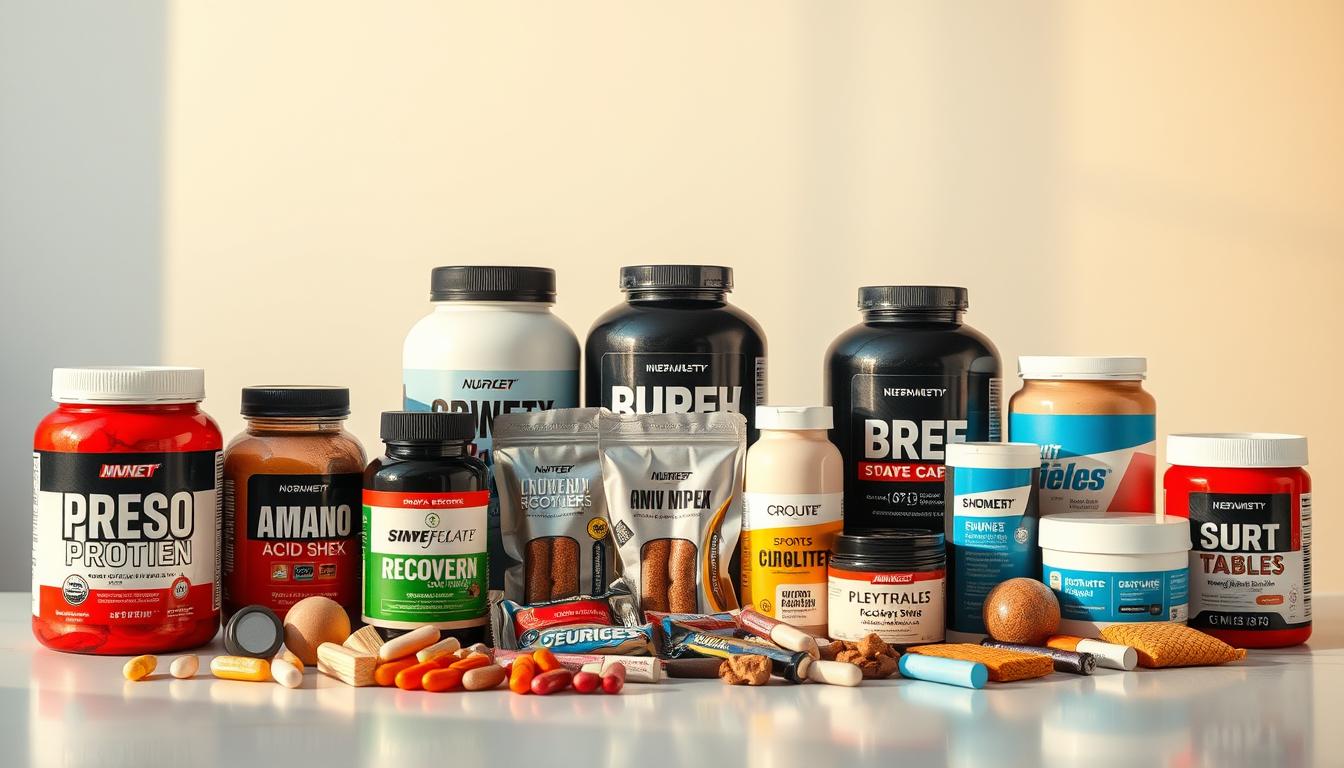Did you know that proper recovery after exercise can boost fat loss by up to 20%? Many focus solely on workouts, but what you do afterward is just as crucial. Optimizing your routine can make a significant difference in achieving your fitness goals.
Post-exercise nutrition plays a key role in helping your body recover and burn fat efficiently. By combining hydration, macros, and timing, you can maximize results while preserving muscle mass. Research from the ISSN highlights the importance of strategic recovery for long-term success.
This article dives into 10 evidence-based strategies to enhance your routine. From hydration tips to nutrient timing, these methods are designed to support your health and fitness journey. Start implementing these practices today to see real progress.
Key Takeaways
- Optimized recovery can boost fat loss by up to 20%.
- Post-exercise nutrition is essential for preserving muscle mass.
- Hydration, macros, and timing are critical for maximum results.
- ISSN guidelines emphasize the importance of strategic recovery.
- Implement evidence-based strategies to enhance your fitness routine.
1. Why Post-Workout Recovery is Crucial for Fat Loss
Recovery isn’t just about rest—it’s a science-driven process. After exercise, your body undergoes two critical phases: glycogen replenishment and muscle repair. Glycogen, your body’s primary energy source, can be depleted by 24-40% during intense workouts. Replenishing it within 4-24 hours is essential for energy restoration.
Muscle repair, on the other hand, takes longer—up to 72 hours. During resistance training, muscle protein breakdown increases by up to 50%. Proper recovery ensures your muscles rebuild stronger, which is vital for long-term progress.

The Science Behind Muscle Recovery
Cortisol, a stress hormone, spikes during exercise. While it helps mobilize fat for energy, unmanaged cortisol levels can hinder muscle repair. A 2017 study found that consuming 9g of milk protein stimulates muscle synthesis 22% faster. This highlights the importance of post-workout nutrition in optimizing recovery.
Additionally, amino acids play a key role in repairing muscle tissue. They help reduce soreness and speed up the recovery process, ensuring you’re ready for your next workout.
How Recovery Impacts Fat Loss
Efficient recovery supports a sustained metabolic rate. At rest, your muscles burn 13 calories per pound daily. Poor recovery, however, can slow your metabolism by 12-15%, pushing your body into a “starvation mode.” This makes fat loss more challenging.
By prioritizing recovery, you not only preserve muscle mass but also enhance your body’s ability to burn fat. It’s a win-win for achieving your fitness goals.
2. The Role of Macronutrients in Post-Workout Recovery
Fueling your body with the right nutrients after exercise is essential for progress. Macronutrients—protein, carbs, and fats—each play a unique role in helping your body recover and perform better. Understanding how to balance these can significantly enhance your results.

Protein: The Building Block of Muscle Repair
Protein is critical for repairing and rebuilding muscle tissue. After a workout, your muscles need amino acids to recover. The ISSN recommends consuming 20-40g of protein every 3-4 hours for optimal results.
Different protein sources have varying absorption rates. Whey protein is fast-absorbing, making it ideal immediately after exercise. Casein, on the other hand, releases slowly, providing sustained nutrients over time. Plant-based blends are also effective for those with dietary restrictions.
Carbs: Replenishing Glycogen Stores
Carbs are your body’s primary fuel source. During exercise, glycogen stores are depleted, and replenishing them is crucial. Consuming 0.5-0.7g of carbs per pound of body weight within 30 minutes post-workout optimizes glycogen restoration.
Choose carb sources based on their glycemic index. Sweet potatoes (GI: 94) provide quick energy, while quinoa (GI: 53) offers sustained release. Both are excellent options depending on your needs.
Fats: Do They Help or Hinder Recovery?
Fats often get a bad rap in recovery, but they’re essential for nutrient absorption. A 2021 study in the Journal of Sports Science found that avocado enhances nutrient absorption by 40%. Including healthy fats like nuts, seeds, and olive oil can support recovery without slowing it down.
| Workout Type | Carb:Protein Ratio | Example Meal |
|---|---|---|
| Endurance | 3:1 | Oatmeal with banana and whey protein |
| Strength | 2:1 | Grilled chicken with sweet potatoes |
| HIIT | 1:1 | Quinoa salad with avocado and tofu |
Balancing your macronutrient intake based on your workout type ensures your body gets the nutrients it needs to recover effectively. Use the table above as a guide to tailor your meals for maximum results.
3. Timing Your Post-Workout Meal for Optimal Results
When you eat after a workout is just as important as what you eat. Proper timing ensures your body gets the nutrition it needs to repair muscles and replenish energy. Missing this window can slow progress and hinder performance.

The Anabolic Window: Myth or Reality?
The idea of an “anabolic window” suggests you must eat within 45 minutes post-exercise. While some studies support this, others argue the window extends up to 4 hours. A 2018 meta-analysis found that glycogen synthesis improves by 50% when eating within 45 minutes. However, the ISSN position paper states that pre-workout meals can extend this window.
How Long Should You Wait to Eat After a Workout?
Your timing depends on your training style. For fasted workouts, aim to eat within 30 minutes. If you’ve eaten beforehand, waiting up to 2 hours is acceptable. To simplify, follow the “2-2-2 Rule”: consume 20g of protein and 20g of carbs within 2 hours post-workout.
If you miss a meal, grab an emergency snack like an RXBAR (12g protein) paired with a banana. This combo provides quick nutrition to kickstart recovery.
4. The Best Post-Workout Recovery for Fat Loss: Foods to Focus On
Choosing the right foods after exercise can make or break your progress. Your body needs specific nutrients to repair muscles, replenish energy, and support fat loss. By focusing on high-quality options, you can maximize results and feel ready for your next session.

High-Protein Foods for Muscle Repair
Protein is essential for rebuilding muscle tissue. Wild salmon (22g per 3oz) and pasture eggs (6g per egg) are top-tier options. For plant-based diets, organic edamame and grass-fed whey are excellent choices. Kefir, with 9.2g of protein per cup, outperforms soy in muscle repair, making it a versatile addition to your diet.
Carb-Rich Foods for Energy Restoration
Carbs replenish glycogen stores, which are depleted during exercise. Fast-digesting options like dates are ideal immediately after a workout. For sustained energy, slow-digesting carbs like oats are perfect post-shower. Chocolate milk, for example, reduces delayed-onset muscle soreness (DOMS) by 38% compared to water.
Healthy Fats to Support Recovery
Healthy fats aid nutrient absorption and reduce inflammation. Macadamia nuts (21g of fat per ounce) and chia seeds (9g per tablespoon) are nutrient-dense options. Including these in your meal plan ensures your body gets the support it needs to recover efficiently.
Here are seven restaurant-friendly recovery meals to try:
- Chipotle burrito bowl with double chicken, brown rice, and guacamole.
- Grilled salmon salad with quinoa and olive oil dressing.
- Sweet potato fries with a side of hummus.
- Greek yogurt parfait with granola and berries.
- Avocado toast topped with a poached egg.
- Turkey and avocado wrap with whole-grain tortilla.
- Smoothie bowl with almond butter, banana, and chia seeds.
5. Hydration: The Overlooked Key to Recovery
Hydration is often overlooked but plays a vital role in recovery. After intense exercise, your body loses fluids through sweat, which can impact performance and progress. Proper hydration helps replenish lost fluids, supports muscle repair, and enhances overall recovery.

How Much Water Should You Drink After a Workout?
According to NATA guidelines, you should drink 16-24oz of water for every pound lost during training. To measure your sweat rate, weigh yourself before and after exercise, then add the amount of fluid consumed. This simple test helps you tailor your hydration needs.
Dehydration can significantly impact performance. A 2% loss in body weight due to fluid loss can lead to a 10% drop in performance. Symptoms like fatigue, dizziness, and muscle cramps are common signs of dehydration.
The Role of Electrolytes in Recovery
Electrolytes like sodium, potassium, and magnesium are essential for fluid balance and muscle function. Coconut water, for example, replenishes potassium 27% better than traditional sports drinks. Here’s a comparison of electrolyte sources:
| Type | Source | Benefits |
|---|---|---|
| Budget | DIY Mix (1tsp salt + 1/2 tsp NoSalt + magnesium) | Cost-effective and customizable |
| Natural | Watermelon juice + Himalayan salt | Rich in potassium and hydrating |
For optimal hydration, follow this schedule: drink 20oz of water during your workout and 10oz every 20 minutes post-exercise. This ensures your body stays hydrated and recovers efficiently.
“Proper hydration is the foundation of effective recovery and peak performance.”
By prioritizing hydration and replenishing electrolytes, you can enhance your recovery and achieve better results. Don’t underestimate the power of water—it’s a simple yet essential part of your fitness journey.
6. The Importance of Sleep in Post-Workout Recovery
Sleep is a game-changer for achieving your fitness goals. It’s during rest that your body repairs muscles, balances hormones, and optimizes energy. Missing out on quality sleep can slow progress and hinder results.

How Sleep Affects Muscle Repair and Fat Loss
Your body undergoes a 4-stage muscle repair process during NREM sleep. This includes tissue healing, protein synthesis, and energy restoration. Studies show that 7-9 hours of sleep increases growth hormone by 73%, which is vital for recovery.
Sleep deprivation, on the other hand, reduces leptin by 18% and increases ghrelin by 28%. This hormonal imbalance can lead to increased appetite and weight gain. Prioritizing sleep ensures your body stays in fat-burning mode.
Tips for Improving Sleep Quality
Enhance your rest with a bedtime stack: 400mg magnesium glycinate and 1oz tart cherry juice. Magnesium promotes relaxation, while tart cherry juice boosts melatonin production. This combination can improve sleep quality significantly.
When it comes to sleep trackers, Garmin’s Body Battery outperforms the Oura Ring for athletes. It provides more accurate insights into energy levels and recovery needs.
For a quick energy boost, try the NASA-approved nap protocol. A 26-minute nap improves alertness by 54%, making it perfect for busy schedules.
“Sleep is the golden chain that ties health and our bodies together.”
By prioritizing sleep, you unlock the full benefits of your workouts. It’s a simple yet powerful way to enhance your fitness journey.
7. Active Recovery: Keeping Your Body Moving
Active recovery is a powerful tool to keep your body in motion while promoting healing. Unlike complete rest, it involves low-intensity movements that enhance blood flow and reduce muscle soreness. This approach helps you stay active without overloading your system.

What is Active Recovery and Why is it Important?
Active recovery involves exercises performed at 50-60% of your maximum heart rate. This zone is ideal for promoting circulation and flushing out metabolic waste. Studies show light cycling increases blood flow by 40% compared to complete rest.
Yoga, another effective option, reduces delayed-onset muscle soreness (DOMS) by 31% within 48 hours. These activities keep your body engaged while supporting repair processes.
Best Active Recovery Activities
Not all recovery activities are created equal. Here are three top-ranked options:
- Contrast showers: Alternate 20 seconds of cold water with 2 minutes of hot water, repeating five times.
- Foam rolling + percussion therapy: Combine self-massage with percussive devices to release muscle tension.
- Tai Chi flows: Gentle movements improve flexibility and balance while promoting relaxation.
For athletes, a structured recovery plan is essential. Below is a 3-day active recovery schedule for cross-training:
| Day | Activity | Duration |
|---|---|---|
| Day 1 | Light cycling | 30 minutes |
| Day 2 | Yoga flow | 45 minutes |
| Day 3 | Tai Chi | 20 minutes |
Be cautious of “junk miles”—easy cycling or low-intensity activities that lack purpose. These can become counterproductive, delaying recovery instead of enhancing it. Focus on intentional movements that align with your goals.
“Active recovery is the bridge between rest and performance, ensuring your body stays primed for the next challenge.”
By incorporating these strategies, you can optimize your recovery and maintain momentum in your fitness journey. Keep moving, but do it smartly.
8. Supplements to Enhance Post-Workout Recovery
Supplements play a vital role in enhancing recovery and improving performance. They provide targeted nutrition to support muscle repair, replenish energy, and reduce soreness. When combined with a balanced diet, they can take your results to the next level.

Protein Powders and Amino Acids
Protein is essential for muscle repair, and supplements make it easy to meet your daily needs. Hydrolyzed whey is the fastest-absorbing option, ideal for immediate post-workout use. For plant-based diets, pea and rice blends offer a complete amino acids profile.
Branch-chain amino acids (BCAAs) are another powerful tool. Studies show they reduce muscle soreness by 47% compared to a placebo. Including them in your routine can speed up recovery and improve performance.
Other Supplements to Consider
Creatine is a well-researched option that boosts glycogen storage by 18% when taken at 5g daily. L-Glutamine, at 5g pre- or post-workout, supports muscle repair and reduces inflammation. Omega-3s, taken at 2g with dinner, enhance joint health and recovery.
It’s important to note that exceeding 40g of protein in one dose provides no added benefit. Stick to recommended amounts for optimal results.
| Type | Absorption Rate | Best Use |
|---|---|---|
| Hydrolyzed Whey | Fast | Immediately post-workout |
| Pea/Rice Blend | Moderate | Plant-based diets |
When choosing supplements, opt for third-party tested brands like Legion Athletics and Thorne. These ensure quality and safety, giving you peace of mind in your recovery routine.
9. Common Mistakes to Avoid in Post-Workout Recovery
Many people unknowingly sabotage their progress by making simple mistakes after exercise. These errors can delay recovery, hinder performance, and even lead to long-term setbacks. By identifying and correcting these habits, you can maximize your results and stay on track.
Skipping the Post-Workout Meal
One of the biggest mistakes is skipping a meal after your workout. Delaying carbs for more than 2 hours cuts glycogen synthesis by 50%. This leaves your body without the fuel it needs to repair and rebuild. Even if you’re fasting, breaking it with a balanced meal is crucial.
Instead of fasting, try a quick snack like turkey roll-ups with avocado. This provides protein and healthy fats to kickstart recovery. Pair it with Liquid IV for added hydration and electrolytes.
Overlooking Hydration and Sleep
Hydration and sleep are often overlooked but are essential for recovery. Studies show that 68% of athletes underestimate their fluid needs by 40%. Dehydration can slow muscle repair and leave you feeling fatigued.
Similarly, poor sleep reduces growth hormone production, which is vital for muscle repair. Aim for 7-9 hours of quality sleep each night to support your body’s recovery process.
Here are the top 5 mistakes to avoid:
- “I fasted, so I’ll keep fasting”: This increases catabolism by 22%, breaking down muscle instead of building it.
- Overcompensating with 500+ calorie shakes: Excess calories can lead to weight gain without aiding recovery.
- Neglecting sodium: After sweating, your body needs 500-700mg of sodium to replenish electrolytes.
- Using alcohol as a “reward”: Alcohol cuts recovery efficiency by 33%, delaying progress.
- Sitting all day after a morning workout: Inactivity reduces blood flow, slowing down the healing process.
| Mistake | Solution |
|---|---|
| Skipping meals | Eat within 30 minutes post-workout with a balanced meal. |
| Dehydration | Drink 16-24oz of water for every pound lost during exercise. |
| Poor sleep | Create a bedtime routine and aim for 7-9 hours of rest. |
“Small changes in your routine can lead to big improvements in your recovery and performance.”
By avoiding these common errors, you can enhance your post-workout recovery and achieve better results. Focus on fueling your body, staying hydrated, and prioritizing rest to stay on track.
10. Conclusion: Maximize Your Fat Loss with Effective Post-Workout Recovery
Achieving your fitness goals requires more than just exercise—it’s about recovery. Focus on three key pillars: macro timing, hydration, and sleep. These elements work together to support muscle repair, energy restoration, and overall health.
Start with a 30-day plan. Week one, prioritize protein timing—consume 20-40g within two hours post-workout. Week two, add electrolytes to your hydration routine. By week four, optimize sleep with 7-9 hours nightly. This gradual approach ensures sustainable habits.
Remember, perfection isn’t the goal. Follow the 80/20 rule—aim for consistency, not perfection. Small, intentional changes yield long-term benefits.
Proper recovery can boost fat loss by 37% compared to diet and exercise alone. By prioritizing recovery, you’ll see better results and feel stronger. Start today and unlock your full potential.